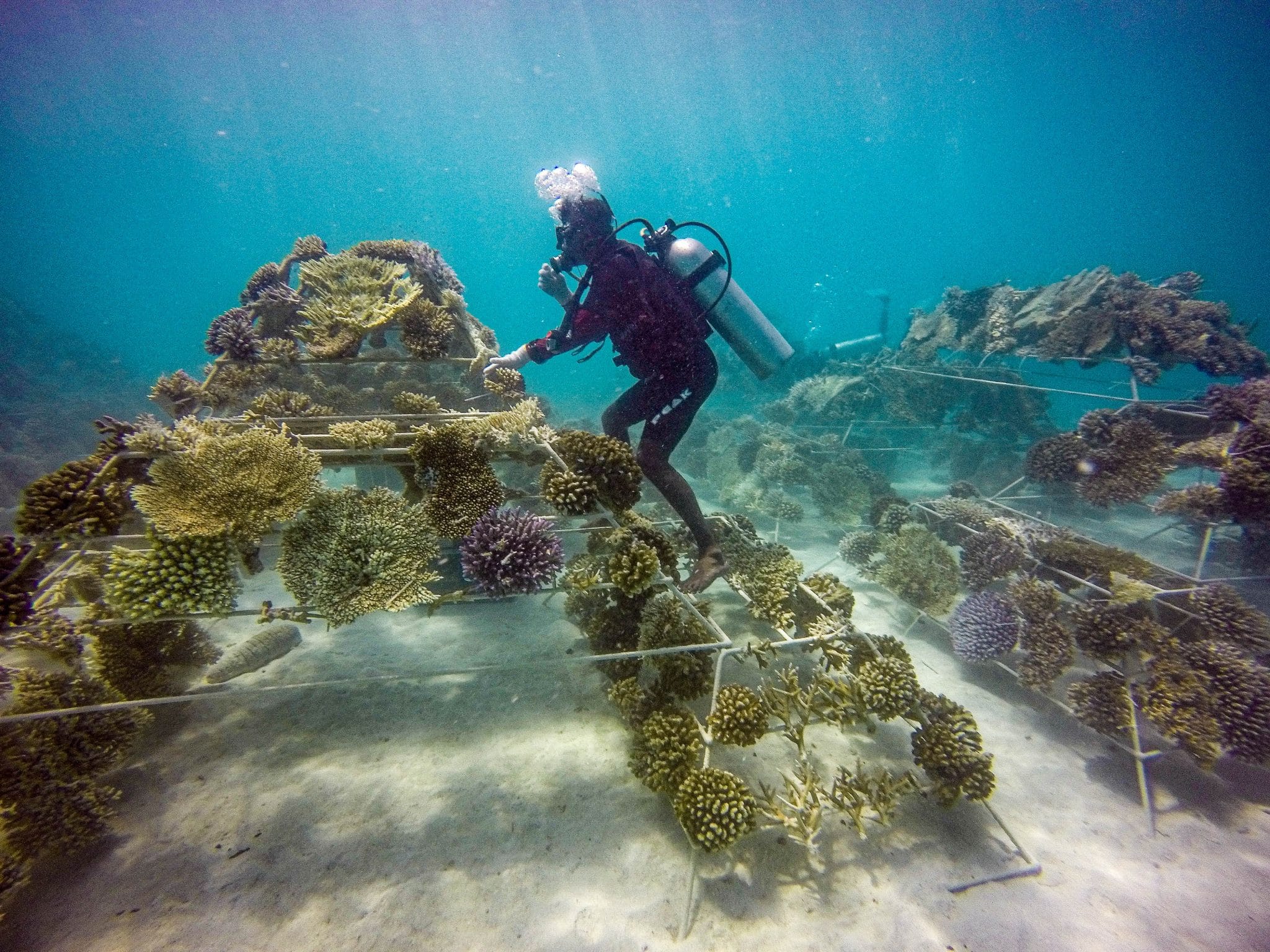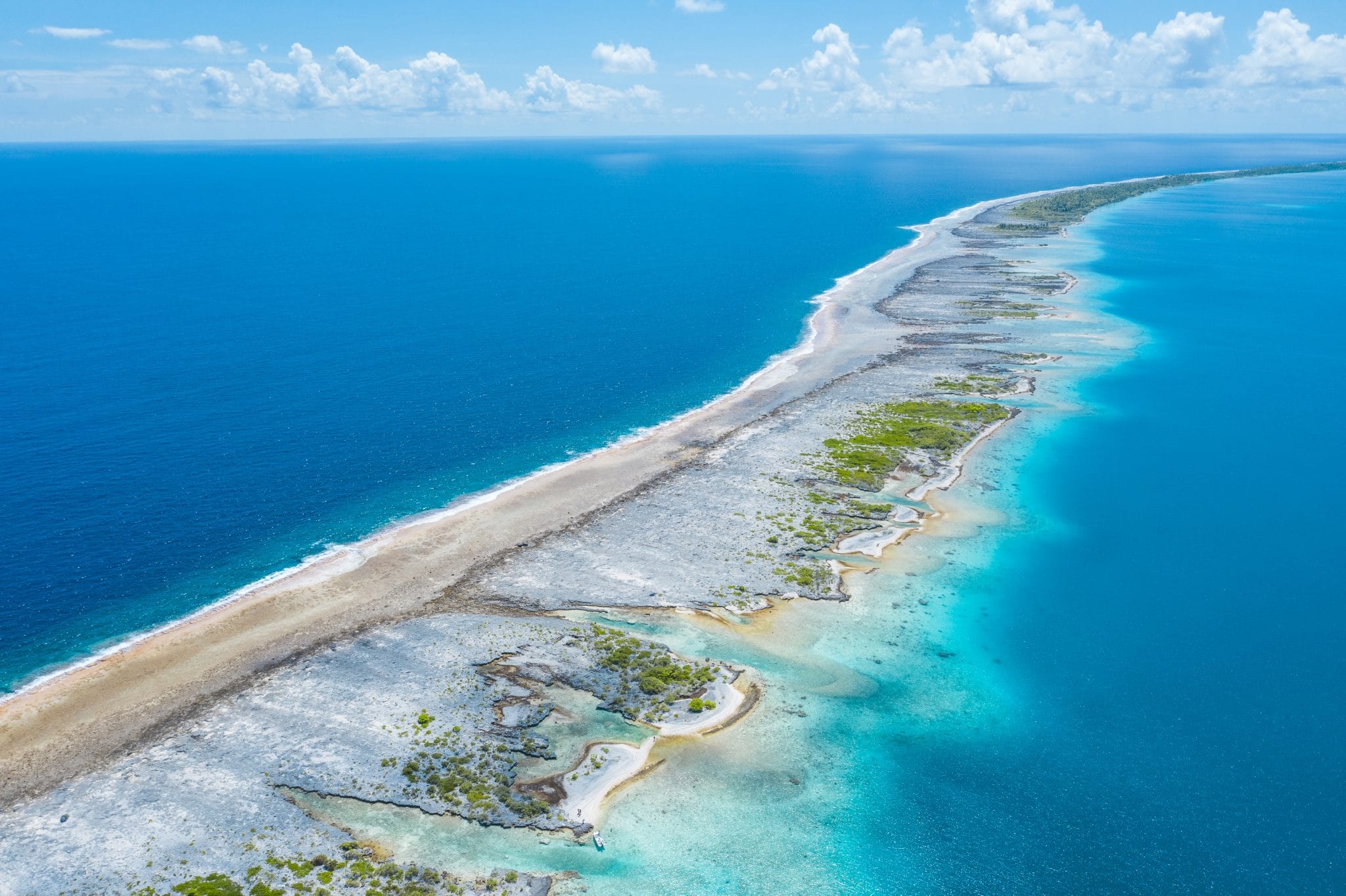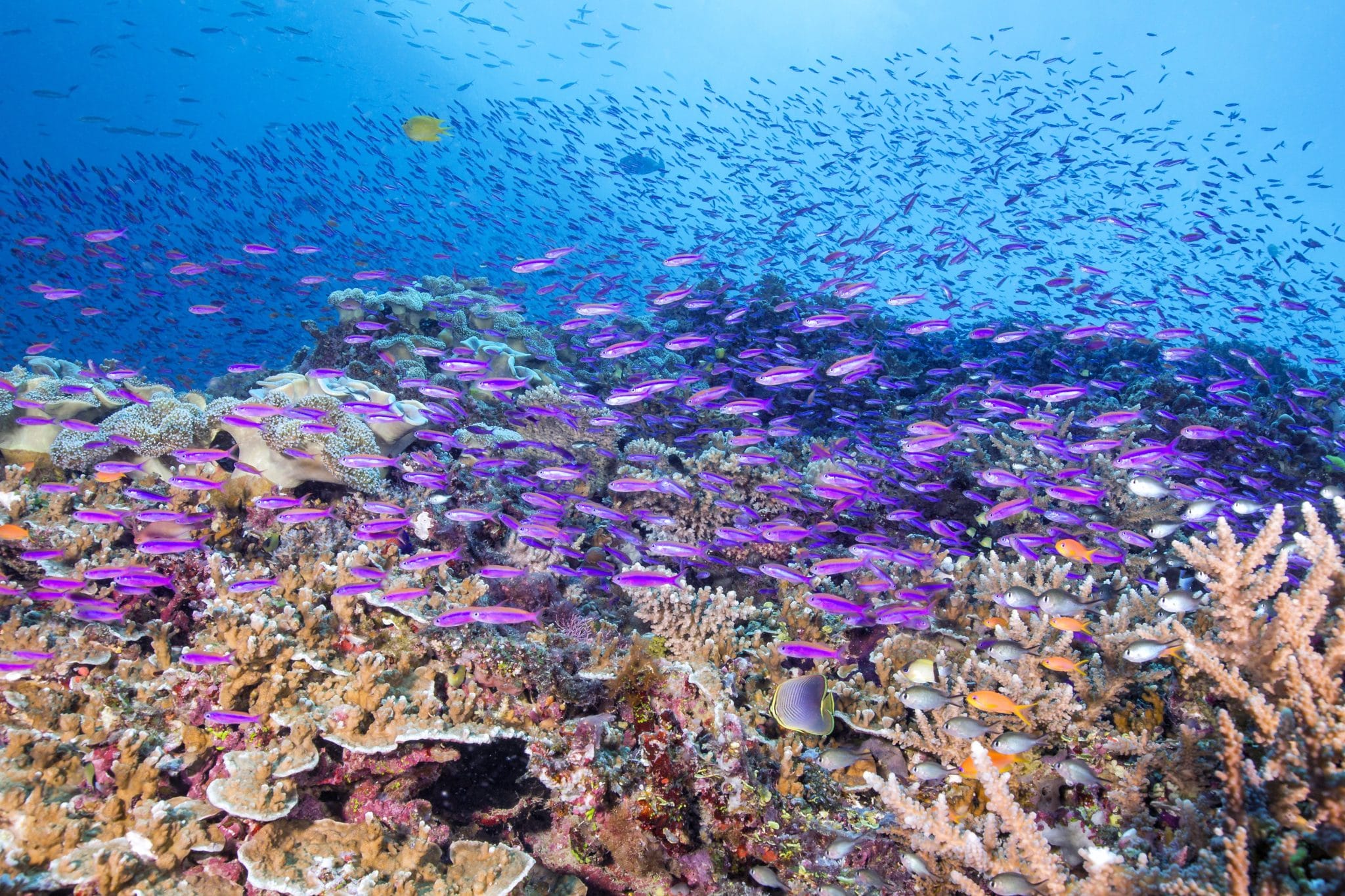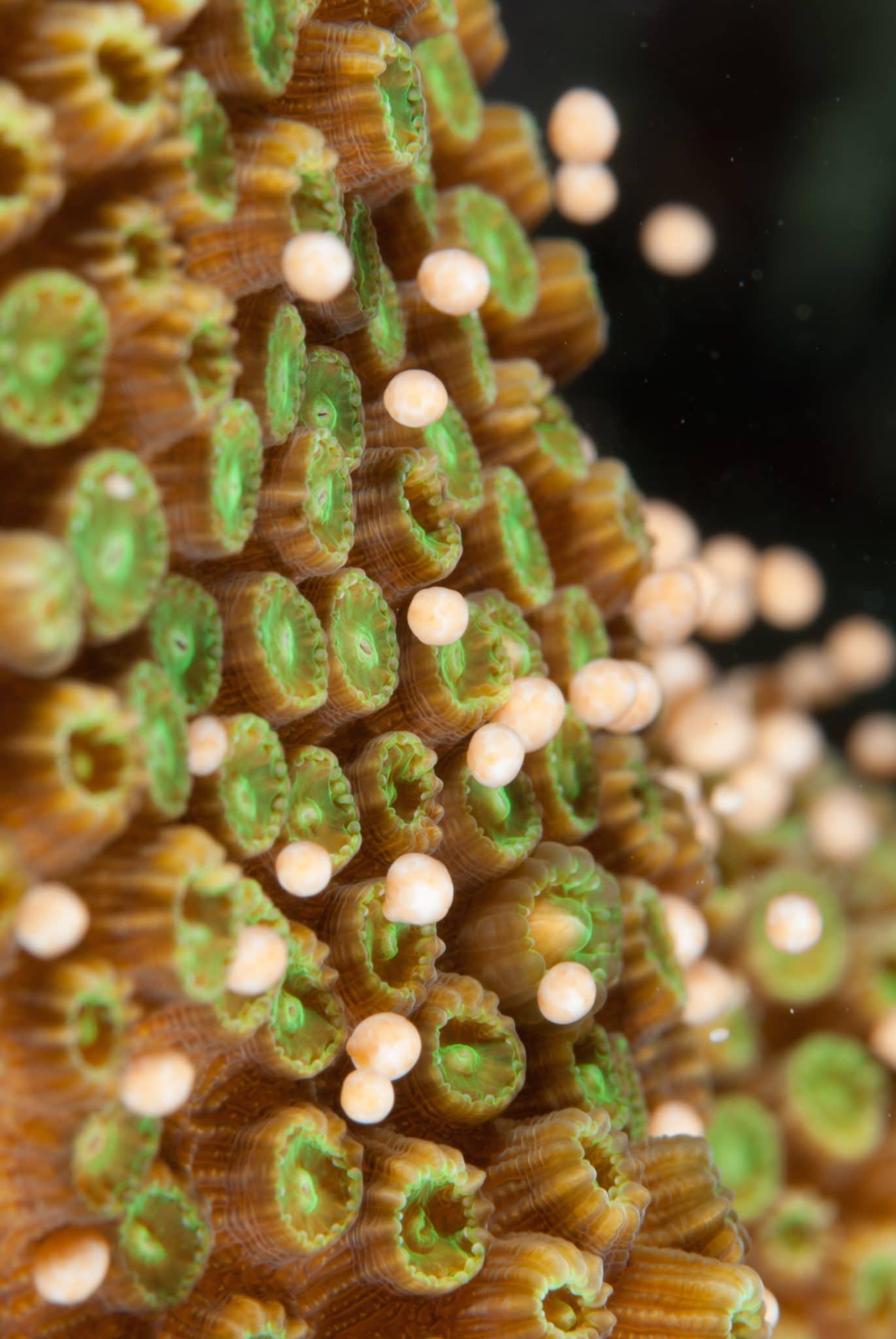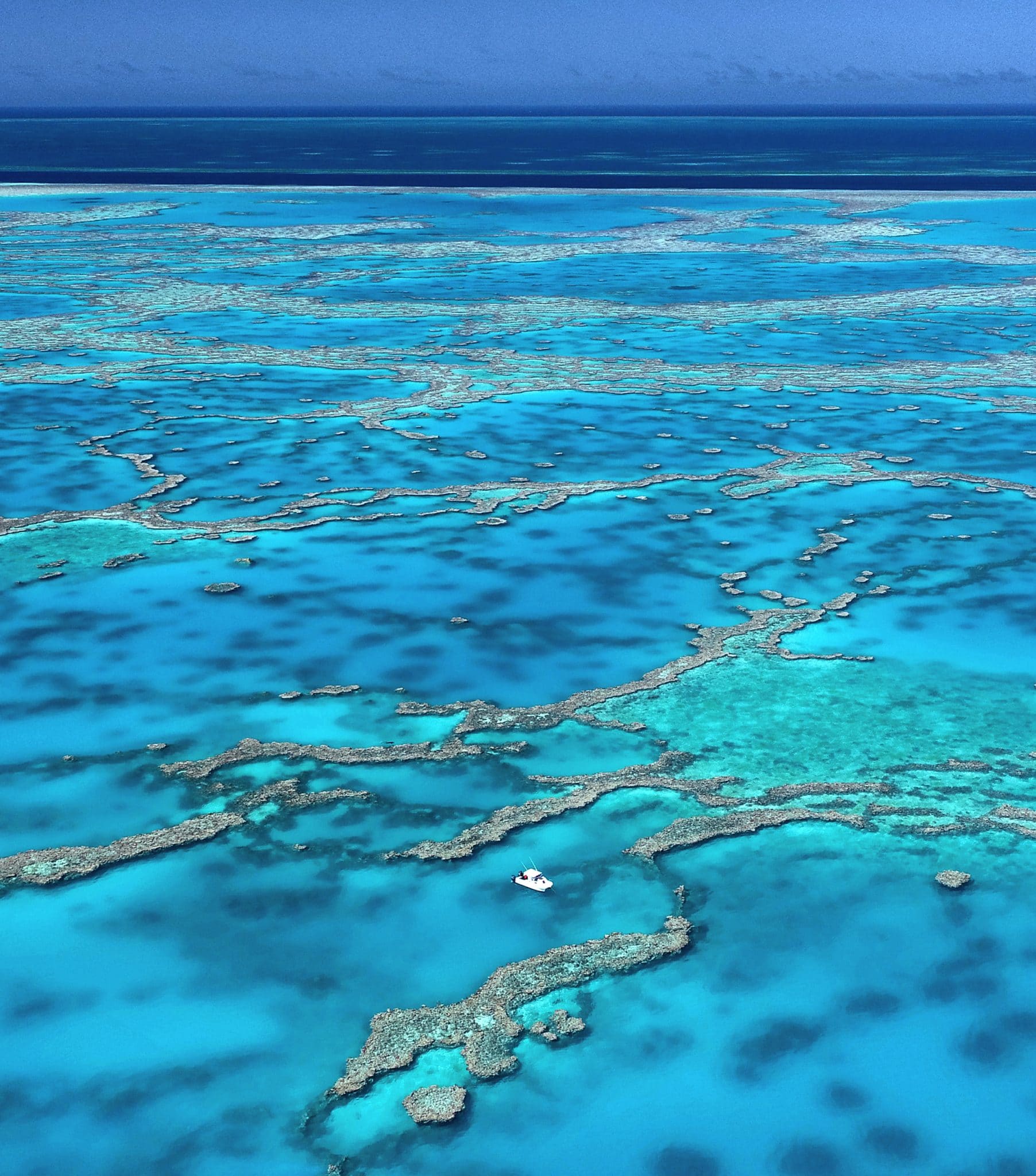Marine Life & Conservation Blogs
World Reef Day: Best Reef Conservation projects and dives from around the world
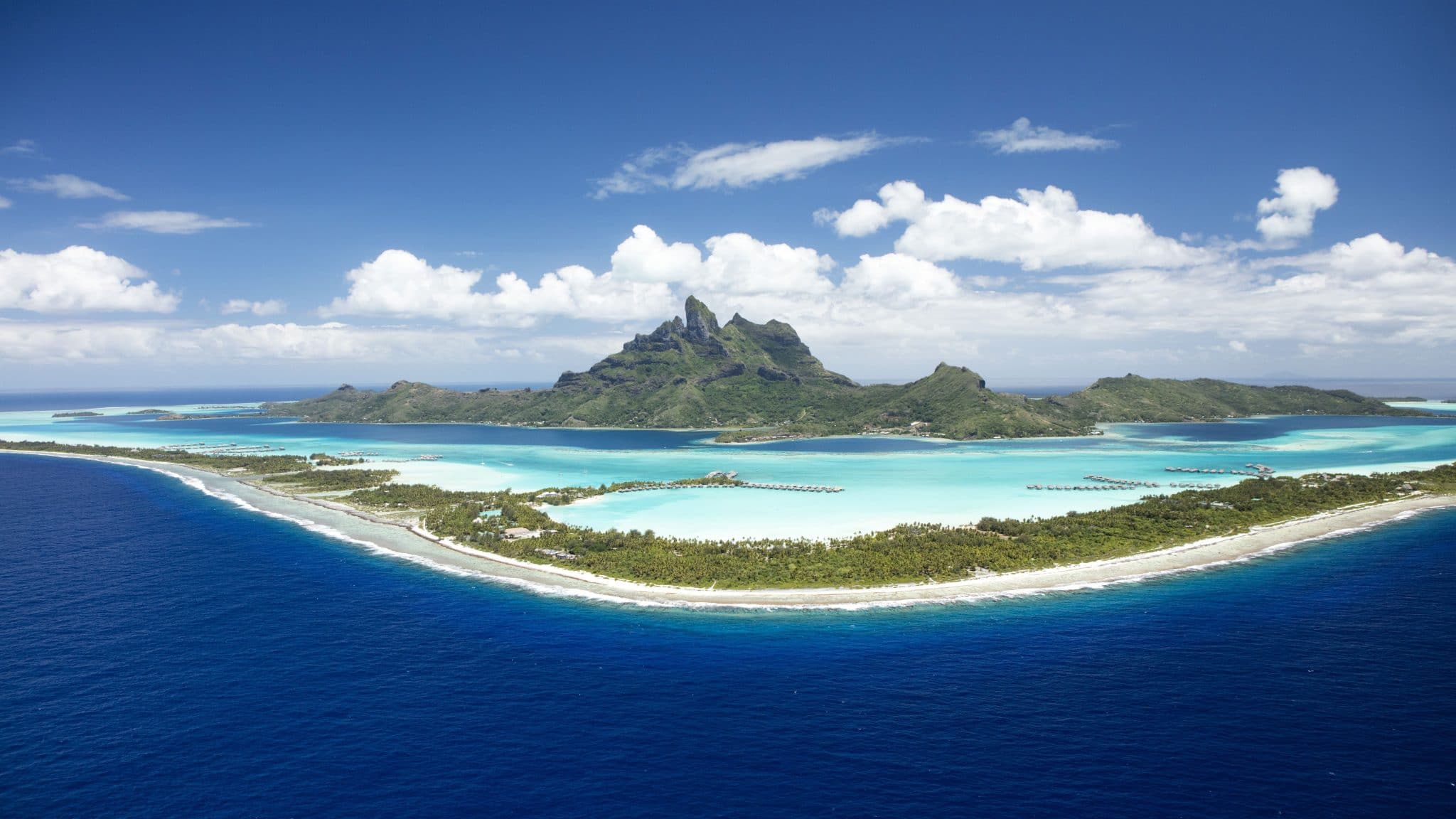
Top Coral Reef Hope Spots
Around the world, destinations are running coral conservation programs that both local communities and visitors can play a direct role in. The results so far have been nothing short of inspiring, proving that hope is not lost in saving coral. Here are PADI’s top coral reef hope spots and how you get involved next time you visit.
1. Maldives: Adopt a Coral Program
PADI Dive Resort Sheraton Maldives Full Moon & Spa is empowering guests to plant hope and become coral champions during their stay. Known as “Adopt a Coral”–which is part of Good Travel with Marriott Bonvoy in collaboration with Reefscapers, the goal is the program is to invite guests to help in planting coral on one of the largest man-made coral structures in the Maldives. Families can also take part in guided house reef snorkeling tours with the resort’s in-house marine biologist Amélie Carraut and kids can take part in her Little Marine Biologists for the day.
2. Tahiti: Pristine Reef Discoveries
Hope was certainly found in Tahiti at the beginning of 2022, when PADI Divers and scientists discovered one of the largest healthy reefs now on record, with two miles of rose-shaped coral spanning the ocean floor as deep as 100ft! The discovery has reminded us all of the importance of exploration and the role it plays in scientific discoveries that can help create ocean change.
Further supporting a healthy coral reef ecosystem in Tahiti are the Coral Gardners, a program designed to plant one million corals and restore life back into the ocean. You can even adopt or gift ten different species of coral and receive growth updates.
3. Fiji: Communities Championing Coral Restoration
Did you know that Fiji is home to 42% of the world’s coral species that span over 10,000 square kilometers throughout the country? There is a reason why the destination is known as the “Soft Coral Capital of the World” and there are numerous coral restoration projects dedicated to preserving it.
In partnership with Fiji’s Ministry of Fisheries, the non-profit Aquaculture Development for the Environment has launched the One Million Coral Planting Program throughout the 333 islands of Fiji. Teaming up with over 20 different coastal villages, each community has a target of collectively planting 1,000 corals per week.
There are also numerous resorts that have programs designed on educating visitors on how they can play a role in rejuvenating and protecting the surrounding coral reefs they are visiting. One of the best places to do this is at PADI Dive Resort Jean-Michel Cousteau Fiji, where their onsite marine biologist teaches guests how to coral plant and help nurse nearly 100 fragments of live coral back to full health.
For those visiting with families, PADI Dive Resort Outrigger Fiji has one of the best reef restoration programs for youth, who host a coral conservation program for kids and teens every Wednesday–with the goal of having them return back home as official eco-warriors.
4. Bonaire: The Coral Pledge to Tourists
The island nation of Bonaire has created a pledge known as ‘The Bonaire Bond’ to help preserve and protect its natural beauty above and below the surface of their surrounding tropical waters.Those who visit the island are asked to sign their pledge to respect the island’s rules designed to help sustain the environment; in return, Bonaire pledges to adopt coral trees through Reef Renewal Bonaire for every visitor who signs the pledge, with the long-term goal of restoring both the coral reefs surrounding the island and marine animals who call it home. Each coral tree is predicted to help nurture 100 pieces of coral.
5. Australia: Become a Reef Ranger at the Great Barrier Reef
Australia’s greatest natural icon–the Great Barrier Reef– stretches 2300 km down Queensland’s coastline and covers more than 344,400km in total. Did you know that the Great Barrier Reef is also the only living organism that can be seen from space and is bigger than the countries of the UK, Switzerland, and Holland combined?
You can become an actual Reef Ranger for the Great Barrier Reef with PADI Dive Centre Keppel Dive & Snorkel, where you will not only get to snorkel over pristine local corals surrounding Keppel Island but have a real role in conducting reef surveys and monitoring reef health.
Or, you can take your PADI Open Water Diver course out at Ludy Musgrave HQ in Bundaberg, where you will learn to dive at some of the most remote and untouched sites only accessible from their pontoon. After you are certified you will also get to take part in citizen science initiatives led by their Master Reef Guides. After a day of exploring in the turquoise waters, you will spend the night out at sea floating under the stars in their zero-carbon accommodation that is 100% powered by wind and solar.
PADI’s Favorite Reef Dives
One of the most magical parts about diving is having the opportunity to have an intimate experience examining and appreciating the wonderfully colourful world of coral reefs and all the life that calls it home. Here are PADI’s favorite reef dives around the world to put on your bucket list for this year.
1. Indonesia: The Coral Triangle
Raja Ampat is located at the intersection of the Indian and Pacific Oceans, right in the heart of the prestigious Coral Triangle. The powerful deep sea currents funnel nutrients into the coral reefs, making Raja Ampat a “species factory.” Home to over 600 species of hard coral, or about 75% of the total in the entire world, Raja Ampat contains the richest coral reefs on the earth and, thus, welcomes in everything from sharks to manta rays and whales.
Best time to dive in Indonesia: October – April
2. Australia: Coral Conservation Expeditions
Sign yourself up for an all-immersive, multi-day expedition through the Great Barrier Reef with No Limit Adventures. The itinerary is created to offer a deep dive into conservation, where you will get your PADI Open Water Diver certification, help monitor the resilience of the surrounding reefs and support the Cairns Turtle Rehabilitation Centre. Led by the Great Barrier Reef Marine Park Authority, you will get over a dozen dives while upon this multi-day liveaboard.
Best time to dive in Australia: year-round, but November is the best month for coral spawning
3. Fiji: The Soft Coral Capital of the World
Leading the way in nature-based tourism are the 333 islands of Fiji, which have taken a destination-wide approach to ensure that Fiji remains the Soft Coral Capital of the World. Even after Cyclone Winston ripped through the South Pacific in 2016, the damaged reefs have completely rebounded thanks to the extra love and nurturing from locals and tourists alike.
One of the best success stories–and places to dive with coral–in Fiji is Waya Island in the Yasawas. With house reefs creating a sparkly sensation of underwater hues as soon as you enter from the shoreline, you can easily spend hours snorkeling, diving and simply admiring the purples, oranges, pinks and blue corals.
Best time to dive in Fiji: July to December
4. Belize: Corals Fit for Royals
The Belize Barrier Reef is perhaps one of the most amazing success stories, having actually been removed from the UNESCO list of World Heritage in Danger. The conservation efforts led by local communities have shown the true power that grassroots efforts can have for real ocean change. In fact, earlier this year Prince William and Kate Middleton dove into the Belize Barrier Reef and surfaced absolutely praising the country for their incredible marine conservation work.
While the Blue Hole is the most iconic spot within the world’s largest reef system, there are tons of other great spots within the reef to explore as well. This includes the Turneffe Atoll, which is the largest atoll in Belize and has a perfectly formed ring-shaped reef creating crystal clear lagoons to dive in.
Best time to dive in Belize: April to June
5. Phillippines: The Seventh Wonder of the World
Tubbataha National Park has just recently been dubbed as the Seventh Wonder of the World and a UNESCO World Heritage Site–and for good reason. With there being a special array of over 100 different types of coral and home to a dozen different species of whale, words really can not describe how sensational diving here is.
Best time to dive in Phillippines: March to June
6. French Polynesia: A Photographer’s Paradise
The Fakarava Atoll in French Polynesia is not only a UNESCO Biosphere Reserve but equally the dream spot for any underwater photographer. With an abundance of diversity in healthy reefs teeming with hard corals and home to grey reef sharks, humpback whales, hammerhead sharks, dolphins, and mantas–it can be overwhelming to choose what shot you want to capture.
Best time to dive in French Polynesia: year-round, with July-December, also being humpback whale season
7. Egypt: The Speedy Success Story
The Red Sea is one of the world’s most recent success stories, with corals so healthy and in such abundance, you will find it hard to believe that the coastline is a sandy, barren desert.
The current here plays a big factor in keeping the corals clean and bringing in a steady flow of zooplankton to keep the reefs nourished, making the coral gardens some of the fastest-growing on the planet. The best case study for this is Sharm el Sheikh, which now thanks to the healthy reef ecosystem is now welcoming back larger marine species like grey sharks and whale sharks back home. One reef not to miss is the Ras Nasrani long coral wall, which is perfect for all experience levels in the ocean.
Best time to dive in Egypt: March-May or September-November
Header IMage: © Grégoire Le Bacon Tahiti Nui Helicopters
Blogs
Invitation from The Ocean Cleanup for San Francisco port call

6 years ago, The Ocean Cleanup set sail for the Great Pacific Garbage Patch with one goal: to develop the technology to be able to relegate the patch to the history books. On 6 September 2024, The Ocean Cleanup fleet returns to San Francisco bringing with it System 03 to announce the next phase of the cleanup of the Great Pacific Garbage Patch and to offer you a chance to view our cleanup system up-close and personal.
We look forward to seeing you there.
To confirm your presence, please RSVP to press@theoceancleanup.com
PROGRAM
Join The Ocean Cleanup as our two iconic ships and the extraction System 03 return to San Francisco, 6 years and over 100 extractions after we set sail, to create and validate the technology needed to rid the oceans of plastic.
Our founder and CEO, Boyan Slat, will announce the next steps for the cleanup of the Great Pacific Garbage Patch. Giving you a chance to view our cleanup system and the plastic extracted.
Hear important news on what’s next in the mission of The Ocean Cleanup as it seeks to make its mission of ridding the world’s oceans of plastic an achievable and realistic goal.
Interviews and vessel tours are available on request.
PRACTICALITIES
Date: September 6, 2024
Press conference: 12 pm (noon)
Location: The Exploratorium (Google Maps)
Pier 15 (Embarcadero at Green Street), San Francisco, CA
Parking: Visit The Exploratorium’s website for details.
RSVP: press@theoceancleanup.com
Video & photo material from several viewing spots around the bay
We look forward to seeing you there!
ABOUT THE OCEAN CLEANUP
The Ocean Cleanup is an international non-profit that develops and scales technologies to rid the world’s oceans of plastic. They aim to achieve this goal through a dual strategy: intercepting in rivers to stop the flow and cleaning up what has already accumulated in the ocean. For the latter, The Ocean Cleanup develops and deploys large-scale systems to efficiently concentrate the plastic for periodic removal. This plastic is tracked and traced to certify claims of origin when recycling it into new products. To curb the tide via rivers, The Ocean Cleanup has developed Interceptor™ Solutions to halt and extract riverine plastic before it reaches the ocean. As of June 2024, the non-profit has collected over 12 million kilograms (26.4 million pounds) of plastic from aquatic ecosystems around the world. Founded in 2013 by Boyan Slat, The Ocean Cleanup now employs a broadly multi-disciplined team of approximately 140. The foundation is headquartered in Rotterdam, the Netherlands, and opened its first regional office in Kuala Lumpur, Malaysia, in 2023.
Find out more about The Ocean Cleanup at www.theoceancleanup.com.
Blogs
Smart Shark Diving: The Importance of Awareness Below the Surface

By: Wael Bakr
Introduction to Shark Diving Awareness
In the realm of marine life, few creatures captivate our interest, and sometimes our fear, like the shark. This fascination often finds a home in the hearts of those who venture beneath the waves, particularly scuba divers who love shark diving. It’s here that shark awareness takes the spotlight. Shark awareness is not just about understanding these magnificent creatures; it’s about fostering respect, dispelling fear, and promoting conservation. As Jacques Cousteau once said, “People protect what they love.” And to love something, one must first understand it.
Shark awareness is not a mere fascination; it’s a responsibility that we owe to our oceans and their inhabitants. From the smallest reef shark to the colossal great white, each species plays a crucial role in the underwater ecosystem. Our understanding and appreciation of these creatures can help ensure their survival.
However, shark awareness isn’t just about protecting the sharks; it’s also about protecting ourselves. As scuba divers, we share the underwater world with these magnificent creatures. Understanding them allows us to dive safely and responsibly, enhancing our experiences beneath the waves.
Importance of Shark Awareness in Scuba Diving
The relevance of shark awareness in scuba diving cannot be overstated. Sharks, like all marine life, are an integral part of the underwater ecosystem. Their presence and behavior directly influence our experiences as divers. By understanding sharks, we can better appreciate their role in the ocean, anticipate their actions, and reduce potential risks.
Awareness is crucial for safety when shark diving. Despite their often-misunderstood reputation, sharks are generally not a threat to humans. However, like any wild animal, they can pose risks if provoked or threatened. By understanding shark behavior, we can identify signs of stress or aggression and adjust our actions accordingly. This not only protects us but also respects the sharks and their natural behaviors.
Moreover, shark awareness enriches our diving experiences. Observing sharks in their natural habitat is a thrilling experience. Understanding them allows us to appreciate this spectacle fully. It’s not just about seeing a shark; it’s about understanding its role in the ecosystem, its behavior, and its interaction with other marine life. This depth of knowledge adds a new dimension to our diving experiences.
Understanding Shark Behavior: The Basics
The first step in shark awareness is understanding shark behavior. Sharks are not the mindless predators they are often portrayed to be. They are complex creatures with unique behaviors and communication methods. Understanding these basics can significantly enhance our interactions with them.
Sharks communicate primarily through body language. By observing their movements, we can gain insights into their mood and intentions. For example, a relaxed shark swims with slow, fluid movements. In contrast, a stressed or agitated shark may exhibit rapid, jerky movements or other signs of discomfort such as gill flaring.
Sharks also use their bodies to express dominance or assertiveness. A dominant shark may swim with its pectoral fins pointed downwards, while a submissive shark may swim with its fins flattened against its body. Understanding these signals can help us interpret shark behavior accurately and respond appropriately.
How Shark Awareness Enhances Scuba Diving Experiences
Shark awareness significantly enhances our scuba diving experiences. It transforms encounters with sharks from mere sightings into meaningful interactions. Knowledge is power, and in this case, it’s the power to appreciate, respect, and safely interact with one of the ocean’s most fascinating inhabitants.
A thorough understanding of behavior when shark diving allows us to interpret their actions and responses accurately. It enables us to recognize signs of stress or aggression and adjust our behavior accordingly. This not only ensures our safety but also promotes responsible interactions that respect the sharks and their natural behaviors.
Furthermore, shark awareness adds a new layer of depth to our diving experiences. It’s one thing to see a shark; it’s another to understand its behavior, its role in the ecosystem, and its interactions with other marine life. This depth of understanding enriches our experiences and fosters a deeper appreciation for our underwater world.
Misconceptions About Sharks: Busting the Myths
Unfortunately, sharks are often misunderstood, feared, and even demonized. These misconceptions can be detrimental, not only to our experiences as divers but also to shark conservation efforts. As part of shark awareness, it’s important to debunk these myths and present sharks in their true light.
First and foremost, sharks are not mindless killing machines. They are complex creatures with unique behaviors and communication methods. They are not interested in humans as prey and, in most cases, prefer to avoid us.
Secondly, not all sharks are dangerous. Out of over 500 species of sharks, only a handful are considered potentially harmful to humans. Most sharks are harmless, and even those that can pose a threat are unlikely to attack unless provoked.
Lastly, sharks are not invincible. They are vulnerable to a host of threats, most notably human activities such as overfishing and habitat destruction. They need our understanding and protection, not our fear and persecution.
Shark Behavior: What to Expect When Scuba Diving
When scuba diving, it’s important to know what to expect from sharks. Most encounters with sharks are peaceful and awe-inspiring. However, as with any wild animal, it’s essential to be prepared and understand their behavior.
Most sharks are shy and cautious creatures. They are likely to observe you from a distance, often circling around to get a better look. This is normal behavior and not a sign of aggression.
However, if a shark becomes agitated or feels threatened, it may exhibit signs of stress such as rapid, jerky movements or gill flaring. In such cases, it’s essential to remain calm, avoid sudden movements, and slowly retreat if possible.
Remember, every encounter with a shark is an opportunity to observe and learn. With understanding and respect, these encounters can be safe, enriching, and truly unforgettable experiences.
Practical Tips for Shark Awareness During Scuba Diving
Being aware of sharks during scuba diving is about more than just understanding their behavior. It’s about applying this knowledge in practical ways to ensure safe and respectful interactions. Here are a few tips for shark awareness during scuba diving.
Firstly, always observe sharks from a safe distance. Avoid approaching them directly or making sudden movements, as this can startle or threaten them.
Secondly, never attempt to touch or feed sharks. This can disrupt their natural behavior and potentially put you at risk.
Lastly, always respect the sharks and their environment. Avoid disturbing their habitat or interfering with their natural behaviors. Remember, we are visitors in their world.
Promoting Shark Conservation through Scuba Diving
Scuba diving offers a unique platform for promoting shark conservation. As divers, we have the privilege of witnessing the beauty and complexity of sharks firsthand. We can share these experiences with others, fostering understanding and appreciation for these magnificent creatures.
Moreover, we can actively contribute to shark conservation. Many diving operators offer opportunities to participate in shark research and conservation initiatives. By participating in these programs, we can help ensure the survival of sharks for future generations.
Lastly, we can advocate for sharks. By sharing our knowledge and experiences, we can help dispel misconceptions about sharks and promote their protection. Every voice counts in the fight for shark conservation.
Courses and Resources for Shark Awareness and Behavior
There are many resources available for those interested in shark awareness and behavior. Scuba Diving International as well as numerous conservation-based organizations offer courses and workshops on shark biology, behavior, and conservation. These courses provide in-depth knowledge and practical skills for interacting with sharks responsibly and safely. From courses like our Marine Ecosystems Awareness Specialty and our Advanced Adventure Certification provide you with the information you need to tackle this new challenge!
Additionally, there are many online resources available, including websites, blogs, and forums dedicated to shark awareness and conservation. These platforms offer a wealth of information and a community of like-minded individuals passionate about sharks.
I encourage anyone interested in sharks to explore these resources, to sign up for one of SDI’s courses call your local dive center or instructor or reach out to your regional representative/ World HQ to find where the class is being taught near you. Knowledge is the first step towards understanding, appreciation, and conservation.
Conclusion: The Role of Shark Awareness in Future Scuba Diving Experiences
As we look to the future, the role of shark awareness in scuba diving will only continue to grow. As our understanding of these magnificent creatures deepens, so too will our appreciation and respect for them. This knowledge will shape our interactions with sharks, enhancing our experiences and promoting responsible and respectful behavior.
Shark awareness is more than just an interest; it’s a responsibility. It’s a commitment to understanding, respecting, and protecting one of the ocean’s most fascinating inhabitants. And it’s a journey that I invite all divers to embark on.
As we dive into the blue, let’s dive with awareness. Let’s dive with respect. And let’s dive with a commitment to understand and protect our underwater world. For in the end, the ocean’s health is our health, and every creature within it, including the sharks, plays a crucial role in maintaining this delicate balance.
-

 Blogs2 months ago
Blogs2 months agoDiving With… Nico, Ocean Earth Travels, Indonesia
-

 News1 month ago
News1 month agoMurex Bangka Announce New Oceanfront Cottages & Beachfront Dining
-

 Blogs2 months ago
Blogs2 months agoA new idea in freediving from RAID
-

 Marine Life & Conservation1 month ago
Marine Life & Conservation1 month agoIceland issue millionaire whale hunter a licence to murder 128 vulnerable fin whales
-

 Marine Life & Conservation2 months ago
Marine Life & Conservation2 months agoThe Shark Trust Great Shark Snapshot is back
-

 News3 months ago
News3 months agoCharting New Waters; NovoScuba Goes Global with the Launch of their Revolutionary Dive Training Agency!
-

 Gear News1 month ago
Gear News1 month agoNew Suunto Ocean – a dive computer and GPS sports watch in one for adventures below and above the surface
-

 Marine Life & Conservation Blogs2 months ago
Marine Life & Conservation Blogs2 months agoBook Review: Plankton


